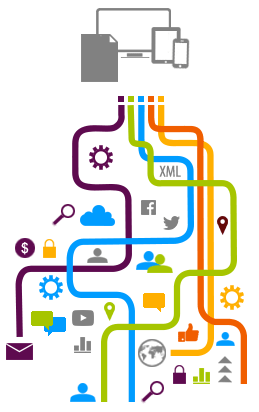Unified Publishing Process
Abstract, adapt and benefit
If a successful industrial manufacturing practice such as SCM is to be applied to publishing, its principles must first be abstracted and then adapted accordingly. One of the key principles of SCM, just-in-time (JIT) delivery, requires a holistic outlook on all participating entities and supply chains.


JIT means delivering ...
- the right part
- in the right quality (zero defects),
- at the right time (now)
- in the right quantity (one unit)
- to the right place (here).
In publishing terms, this means delivering ...
- the right content (text, picture, video, etc.),
- in the right quality (a compelling story, well researched and told in captivating words and images)
- at the right time (when a task needs to be done)
- in the right package (together with all the associated elements and information)
- to the right place (the editor, graphic designer, etc.).
This is the basic idea abstracted from industrial applications and adapted to publishing workflows. Of course, at this point we are still looking at this on a very superficial level with the JIT principle merely serving as a rough road map to our destination, which is greater efficiency in publishing. There are several legs to this journey, the speed, distance and time of which depend largely on the system’s capabilities and the users’ learning curve. However, the advances that have been made in publishing so far are quite similar to the trajectory that developments in SCM took.
Let us look closer at these phases:
PHASE 1 Standardize internal processes
The first step is to put in place a system that defines workflows, users, roles and the appropriate permissions, and then coordinates the team’s efforts. This initial phase often demands a great deal of effort. Many contributors are concerned that their creativity will suffer if they are compelled to work with such a system. The company has to make this effort because the payoff comes early, as mid-term results would bear out: Productivity increases as the team has to devote far less time and resources to coordinate their efforts.
The system takes on most of these tasks, and everyone knows exactly when it is their turn to contribute and precisely what has to be done. This makes the workflow so much more transparent and manageable. Project managers and editors-in-chief can ascertain the project’s status at a glance whenever they wish. And the time that is saved on routine chores can be better devoted to enhancing the quality of content.
PHASE 2 Standardize external communications
Once internal processes have been standardized, the company must direct its attention outward. Different systems tend to operate autonomously even when they are used by the same teams for a common purpose. Powerful standard interfaces such as a Web Services API and standardized data formats such as XML facilitate data transfer with digital asset management, web content management and other third-party systems.
Outside contributors and remote locations also have to be integrated into the system’s workflows. What’s more, this needs to be done so that the timing of their contributions is just as process-driven as those of in-house staff. With outside workflows redirected into the system, the publishing process becomes more reliable and manageable.
PHASE 3 Automate routine tasks
Individual tasks can be automated once external and internal processes have been standardized and mapped to a uniform workflow. This applies mainly to the routine manual chores that are so time-consuming. The system may initiate these automated routines at a specific point in the workflow or at a time to be freely designated by the user.
This also conserves resources that can be put to better use in pursuit of greater quality and creativity. On top of that, automated routines mitigate the risk of errors, for example, when packaging tablet articles or uploading these to the given delivery service.
PHASE 4 Synchronize and streamline processes
The final phase never ends in that all processes are continuously improved. More and more tasks are incorporated into the process-driven workflow. Some are accelerated while others that are no longer needed fall by the wayside. Several automated routines can be combined into one new automated process chain. For example, the content for different tablets and smartphones can be automatically extracted from a single layout, converted, packaged and conveyed to the given delivery service for testing or publishing purposes.
In this phase, the central system also controls processes that have been outsourced to connected systems. It loads the incoming results – for example, edited images – back into the actual workflow once the outsourced task has been accomplished. And if the system provides the necessary functions, tasks that have always been performed by outside applications can even be reassigned to the system.
Benefits on all levels
While conventional publishing and content management systems are equipped to cover phases 1 and 2, they fare rather less well in phase 3. Many systems are severely limited in their ability to accommodate automated routines. Granted, such routines may be added to and managed in some of these systems, but only with great effort. Phase 4, when it comes time to constantly adapt and improve processes, is the ultimate test of a system’s flexibility and utility.
Only a select few can make the transition to phase 4, but those that do deliver considerable benefits to the user. This is where the abstraction and adaptation of principles culminates, where the philosophy behind supply chain management becomes the Unified Publishing Process.
The benefits are many:
- Smooth workflows driven by synchronized, highly automated processes
- Stable, well-balanced publishing routines built on rock-solid standardized and harmonized practices
- A lean process where everyone works with precisely the contents that are needed at the time
- Far fewer errors with transparent processes, fast feedback and flexible emergency scenarios
UPP not only streamlines processes for a leaner, better workflow; it also enhances the quality of both digital and printed publications.
The Unified Publishing Process provides the technical means for publishers and corporates to enjoy vast improvements in teamwork to deliver efficiently across diverse media, and put organizational and business strategies such as agile publishing and content marketing into practice.
“It pays to invest in the Unified Publishing Process because of these many benefits, and especially the cost savings and productivity gains.”
Andreas Schrader, CEO & Founder, vjoon
Do you know our DAM?
vjoon seven is your central content hub. Its unique integration with K4 makes it essential in any publishing environment.
Learn more with vjoon TV
Do you already know our video channel? Our customers, partners and us share experience – you will get inspired.
Want a tour of K4?
Request a personalized demo with one of our experts and get a guided tour through K4.
